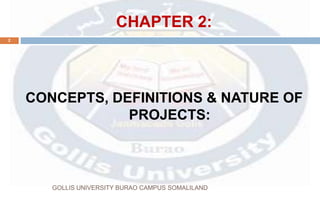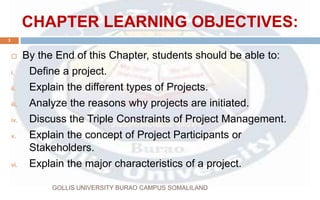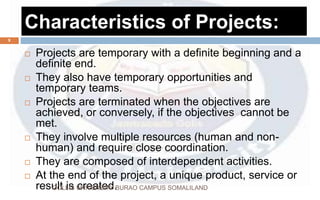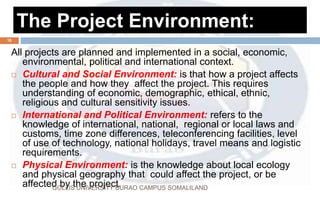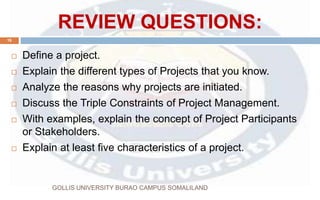Project Management Chapter Two BBA .pptx
- 1. PROJECT PLANNING & MANAGEMENT: GOLLIS UNIVERSITY FACULTY OF BUSINESS ADMINISTRATION & ECONOMICS SEMESTER SIX
- 2. CHAPTER 2: CONCEPTS, DEFINITIONS & NATURE OF PROJECTS: 2 GOLLIS UNIVERSITY BURAO CAMPUS SOMALILAND
- 3. CHAPTER LEARNING OBJECTIVES: GOLLIS UNIVERSITY BURAO CAMPUS SOMALILAND 3 ’é© By the End of this Chapter, students should be able to: i. Define a project. ii. Explain the different types of Projects. iii. Analyze the reasons why projects are initiated. iv. Discuss the Triple Constraints of Project Management. v. Explain the concept of Project Participants or Stakeholders. vi. Explain the major characteristics of a project.
- 4. WHAT IS A PROJECT? ’é© ŌĆ£A project is a problem scheduled for solution.ŌĆØ ’é© Problem refers to the gap between where you are and where you want to be, with an obstacle that prevents easy movement to close the gap. Projects are a group of activities that have to be performed with limited resources to yield specific objectives, in a specific time, and in a specific locality. ’é© Thus, a project is a temporary endeavor employed to create a unique product, service or results. 4 GOLLIS UNIVERSITY BURAO CAMPUS SOMALILAND
- 5. ’é© Projects are an investment on which resources are used to create assets that will produce benefits over an expanded period of time. ’é© It is a unique process, consisting of a set of coordinated and controlled activities with start and finish dates, undertaken to achieve an objective conforming to specific requirements, including the constraints of time, cost and resources. 5 GOLLIS UNIVERSITY BURAO CAMPUS SOMALILAND
- 6. Short Range Projects: ’é© They are completed within one year, and are focused towards achieving the tactical objectives. They are less rigorous; require less or no risk. They are not cross functional. These projects require limited Project Management tools, and have low level of sophistication. It is easy to obtain approval, funding and organizational support for short range projects. 6 GOLLIS UNIVERSITY BURAO CAMPUS SOMALILAND
- 7. Long Range Projects: ’é© These projects involve higher risk and a proper feasibility analysis is essential before starting such projects. They are most often cross functional. Their major impact is over long period of time, on internal as well as external organization. Large numbers of resources are required to undertake long range projects and they require breakthrough initiatives from the members. 7 GOLLIS UNIVERSITY BURAO CAMPUS SOMALILAND
- 8. Why are Projects initiated? Projects are initiated in the following scenarios: ’é© When starting a new business. ’é© In order to develop/ modify a product or service. ’é© For relocating and/or closing a facility. ’é© For regulatory mandate. ’é© For some community issues. ’é© In order to re-engineer the process so as to reduce complaints, reduce cycle time, and eliminate errors. ’é© For implementing a new system or process. ’é© To introduce new equipment, tools or techniques. 8 GOLLIS UNIVERSITY BURAO CAMPUS SOMALILAND
- 9. Characteristics of Projects: ’é© Projects are temporary with a definite beginning and a definite end. ’é© They also have temporary opportunities and temporary teams. ’é© Projects are terminated when the objectives are achieved, or conversely, if the objectives cannot be met. ’é© They involve multiple resources (human and non- human) and require close coordination. ’é© They are composed of interdependent activities. ’é© At the end of the project, a unique product, service or result is created. 9 GOLLIS UNIVERSITY BURAO CAMPUS SOMALILAND
- 10. The Project Environment: All projects are planned and implemented in a social, economic, environmental, political and international context. ’é© Cultural and Social Environment: is that how a project affects the people and how they affect the project. This requires understanding of economic, demographic, ethical, ethnic, religious and cultural sensitivity issues. ’é© International and Political Environment: refers to the knowledge of international, national, regional or local laws and customs, time zone differences, teleconferencing facilities, level of use of technology, national holidays, travel means and logistic requirements. ’é© Physical Environment: is the knowledge about local ecology and physical geography that could affect the project, or be affected by the project. 10 GOLLIS UNIVERSITY BURAO CAMPUS SOMALILAND
- 11. Project Participants: 11 GOLLIS UNIVERSITY BURAO CAMPUS SOMALILAND
- 12. Stakeholders: ’é© Stakeholders are the ones who have a share, or an interest in an enterprise. Stakeholders in a company may include shareholders, directors, management, suppliers, government, employees, customers, and the community. ’é© Stakeholders are influenced by the outcomes and objectives. They have varying level of responsibility and authority. Thus, they should not be ignored. A project manager should try to manage and fulfill the expectations of the stakeholders. 12 GOLLIS UNIVERSITY BURAO CAMPUS SOMALILAND
- 13. ContŌĆ” ’é© Project stakeholders are individuals and organizations that are actively involved in the project, or whose interests may be affected as a result of project execution or project completion. They may also exert influence over the projectŌĆÖs objectives and outcomes. ’é© The project management team must identify the stakeholders, determine their requirements and expectations, and, to the extent possible, manage their influence in relation to the requirements to ensure a successful project. 13 GOLLIS UNIVERSITY BURAO CAMPUS SOMALILAND
- 14. ContŌĆ” ’é© Stakeholders may have a positive or negative influence on a project. Positive stakeholders are those who would normally benefit from a successful outcome from the project, while negative stakeholders are those who see negative outcomes from the projectŌĆÖs success. 14 GOLLIS UNIVERSITY BURAO CAMPUS SOMALILAND
- 15. Key Stakeholders include: ’é© Project Manager: ’é© Customers, End Users: ’é© Performing Organization: ’é© Project Management Team ’é© Project Team Members: ’é© Sponsors: ’é© Influencers: 15 GOLLIS UNIVERSITY BURAO CAMPUS SOMALILAND
- 16. Relevant stakeholders: 16 GOLLIS UNIVERSITY BURAO CAMPUS SOMALILAND
- 17. Sub Projects: GOLLIS UNIVERSITY BURAO CAMPUS SOMALILAND 17 ’é© Projects are frequently divided into more manageable components or sub projects. ’é© Individual sub projects are also a project and are managed as such. They can be sub contracted or out sourced.
- 18. Triple Constraints of Project Management: GOLLIS UNIVERSITY BURAO CAMPUS SOMALILAND 18 ’é© Meeting stakeholder needs and expectations involves balancing competing demands among cost, quality, scope, and time. Q = f (T, C, S) ’é© Where Q is Quality, S is Scope and T is Time. ’é© Project quality is affected by balancing these three factors. ’é© Projects fail when: ’ü« Estimates are faulty ’ü« Time, talent and resources are insufficient or incorrectly applied
- 19. REVIEW QUESTIONS: GOLLIS UNIVERSITY BURAO CAMPUS SOMALILAND 19 ’é© Define a project. ’é© Explain the different types of Projects that you know. ’é© Analyze the reasons why projects are initiated. ’é© Discuss the Triple Constraints of Project Management. ’é© With examples, explain the concept of Project Participants or Stakeholders. ’é© Explain at least five characteristics of a project.
- 20. GOLLIS UNIVERSITY BURAO CAMPUS SOMALILAND 20 END


